top of page
INTERACTION DESIGNER / PRODUCT DESIGNER
Leading Minds Lab
UI/UX Design, Visual Design, User Research
A smart application Platform designed for Leading Minds Lab to match entrepreneurs and mentors based on their values, motivations, and goals

ROLE
Visual Design
UI/UX Design
User Research
TOOLS
Adobe Illustrator
InVision
COLLABORATORS
Lucas Di Monte
Chi-Hua Lin
Yuqi Yang
PROJECT OVERVIEW
Leading Minds Lab wants to develop an application platform that would effectively and quickly match the right mentors and entrepreneurs based on their values, motivations, and goals. The goal of this project was to gather data related factors that will inform the design and development of a useful platform that would facilitate mentors and mentees engaging in a lasting, meaningful and mutually beneficial experience.
PROJECT BACKGROUND
The purpose of this project was to gather information from mentors and entrepreneurs looking to enter into a mentor-mentee relationship, in order to establish key factors that would foster lasting participation from all parties. A critical component of our research will be uncovering the specific motivations behind mentorship participation.
STAKEHOLDER
LEADING QUESTION
How might we uncover the motivations of mentors and entrepreneurs and design a smart, user-focused platform that delivers a rewarding interaction between these participants, based on their motivations?
FINAL APPLICATION
PROJECT PROCESS OVERVIEW
Research
User Interview
Gathering valuable data
Data Analysis
Analyze data
DIKW Schema
Flowchart
Wireframe
Prototyping
Prototype
Evaluation
Reflection
Develop
Learning
RESEARCH
research
Target Users
Before we redesign the system, the first and most important thing is to determine the target users and understand them, what are their needs or pain points. After some thought, we determined that the focus of our research should be directed more towards the motivation of mentors, as we saw mentors as more crucial to the success of the platform. We primarily used exploratory methodology with strategic use of generative questions. We conducted semi-structured interviews through phone calls with four LML provided-mentors located throughout southern Ontario.
Research Participants
LML provided-mentors
A Sampling of entrepreneurs provided by Toronto Entrepreneurs Meetup (15,000members)
Leading Minds Lab Founders and Developers
Research Methods
I. Semi-structured Interviews - A semi-structured interview is a research method that combines open pre-set questions and allows new ideas to be brought up during the interview as a result of the interviewee’s answers. This method encourages the interviewer to spontaneously branch out and could lead to important questions which the interviewer may not have considered.
II. Five Whys - The Five Whys method is a simple research method used to better understand the subject’s needs. It involves asking them “why” five times after they answer a broad question.
III. Think Aloud - Think Aloud is a usability test where researchers directly observe the users. Users are asked to perform or think of a task and tell the researcher their thought process. This method helps researchers identify what aspects of the system are confusing, and also helps to determine a user's expectations.
IV. Secondary source research will include research into the mindset and motivations of both entrepreneurs and mentors in general.
DATA ANALYSIS
visualizing data
Analyzing Data
After we conducted all the interviews and gathered the data, we moved on to analyze and translate those raw data which we collected from our research and interviews into a useful format. We grouped all the data into four different categories, which are Motivation, Rewards and Recognition, the platform, Mentoring entrepreneurs, and Communication. We used bullet points to express the main ideas toward those answers.
"Mentorship is a two-way information exchange."
"As a volunteer, mentoring more than 2 companies at a time becomes “very difficult”, 2 to 3 maximum because you have to learn their business."
"A system that would quantify the expectations in the relationship."
"Team mentorship is ideal"
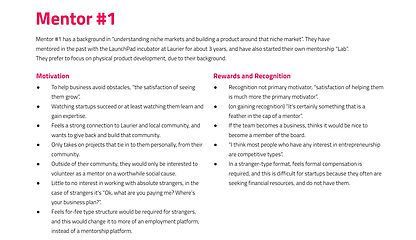

DIKW Schema
All the data already categorized into different groups, then we created a DIKIW Scheme as part of our "sense-making" evaluation. We pulled direct quotes from our research and identified similarities, differences, patterns and behaviors across all our data. This allowed us to identify key insights and key concepts for our solution.
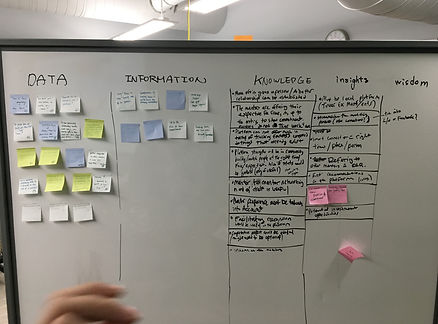
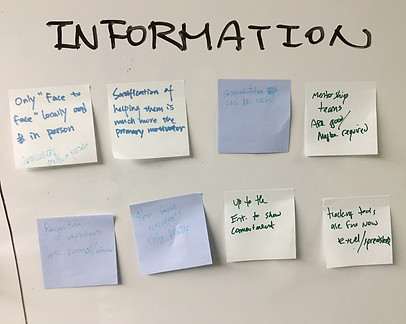
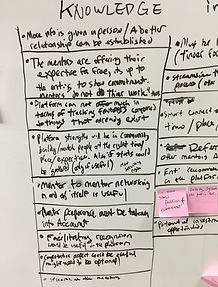


Key Insights
Ideas for Conceptualization
Platform must be local
Mentors and entrepreneurs prefer face to face meetings, meaning matches must be local in order for
meetings to happen.
Smart connections
The platform will automatically match mentors and entrepreneurs at the right time, place, and person.
Platform strengths will be in community building and gathering useful stats to improve matching
system.
Streamline the matching process
Options to tie accounts with social media accounts (Linkedin, Facebook and etc.) for easier means of
knowing each other. When more info is given, a better relationship can be established between them.
Gatekeeping
The platform will lose merit if mentors and entrepreneurs are not qualified, so there must be a system in place that determines what constitutes a real mentor and a real entrepreneur.
Smart, Informed Matching
Matching requires data, and users will need to provide some data when they create an account.
Connecting & Establishing A Framework
A Token Of Recognition
The platform facilitates the basic terms of the mentorship, so it will know when the term is complete.
Key Features
- Completely streamline the matching and decision-making process and aid in laying the foundation of a mentorship relationship.
- Geolocation, and leveraging existing social media accounts for validation.
- 3rd party login with Linkedin and Facebook.
- Mentor profiles showcasing expertise, experience, and proof of the previous mentorship.
ideation
IDEATION & CONCEPT
Flowchart
According to the DIKW Schema and also the final summary report, we listed and showed all the needed pages for the application by using the flowchart

Wireframe
Basing on the flowchart, we used Illustrator to cover those sketched to the low-fidelity grey wireframes, which is used to be the guideline and template for us to make the prototype.

PROTOTYPING
prototype
Style Guide

Final Prototype

Main Page
Just click the button on the page to log in or sign up an account
Sign Up
The only need for creating an account is to fill your personal information and choose your identification. Don't want to fill the form? No worries, you can just connect with your Facebook account or Linkedin account by clicking the buttons below

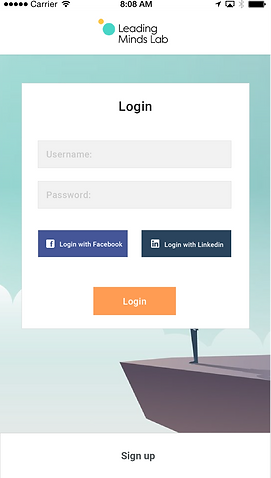
Search Page (Mentors)
Check the entrepreneurs who need your help, according to their pitch video and profile to decide your choice
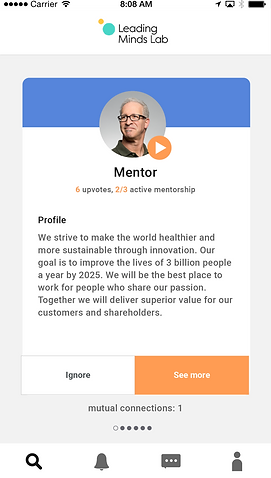
See More
Information is not enough? Click the See More button to check their information in detail. Thought he/she is the right person to choose? Just click "Interested" and try to contact with them
Login
Already had an account? Just log in with your username and password or logging with your Facebook or Linked

Search Page (Entrepreneurs)
Check the recommended mentors, according to their pitch video and profile to decide your choice


Contact
Simply click the Interested button to contact the person you need
Message
Want to check chat history? The only thing you need to do is to click the message icon at the bottom


Notification
Click the bell icon at the bottom to check new notifications
Profile
Add more business and personal information to let more people choose you, also a customizable radius setting to help you find the more suitable mentors/entrepreneurs

EVALUATION
evaluation
Reflection & Learning
I feel very honored to design the application platform for Leading Minds Lab, this is the first time that I conducted a formal interview and communicated with the target users who really will use this platform. I learned how to get to know users in a more professional way, which is very helpful for my further projects.
bottom of page
